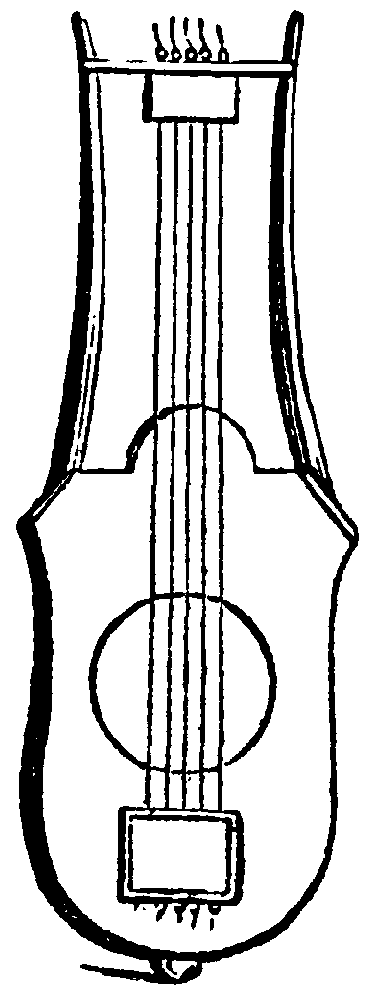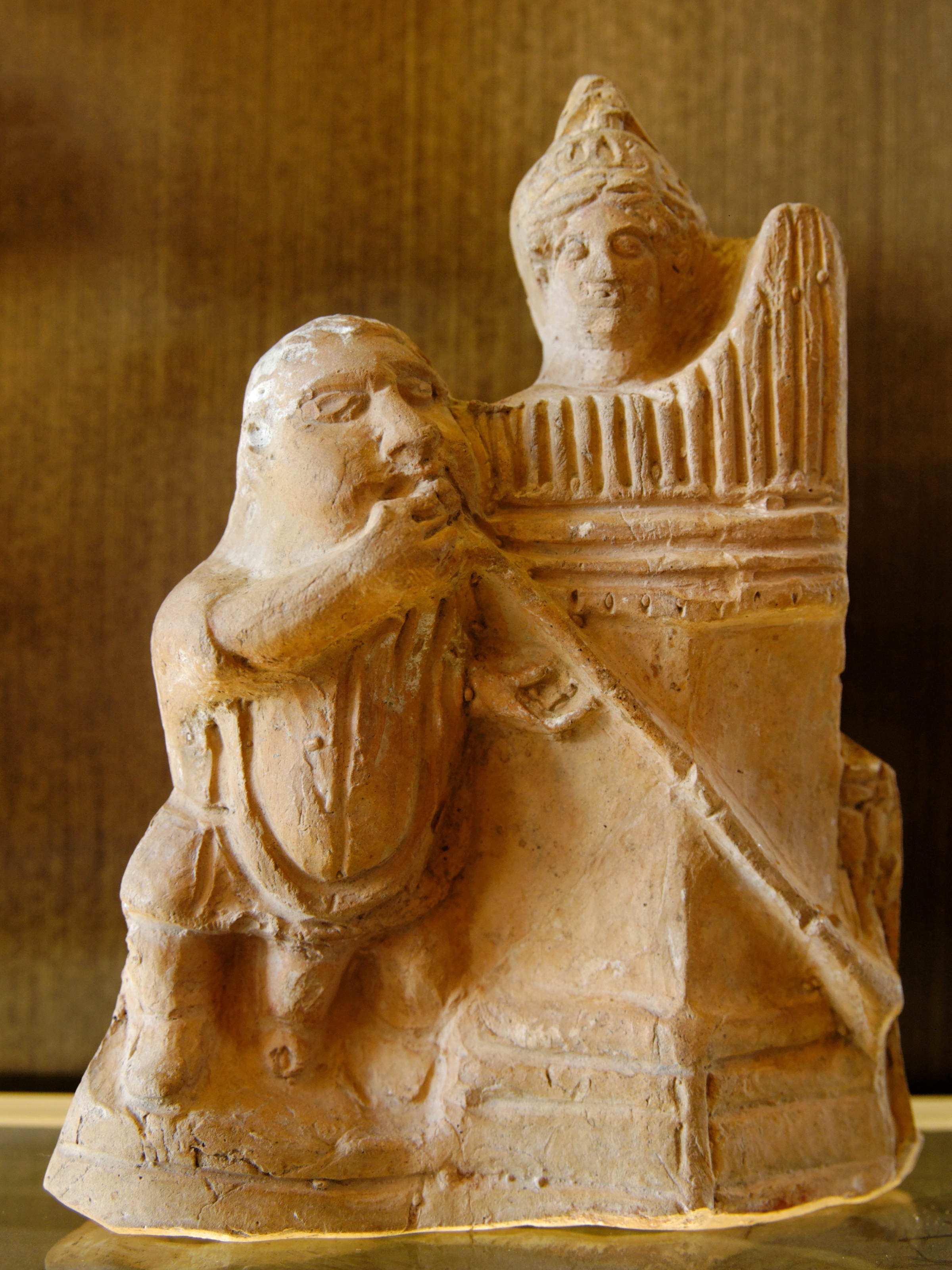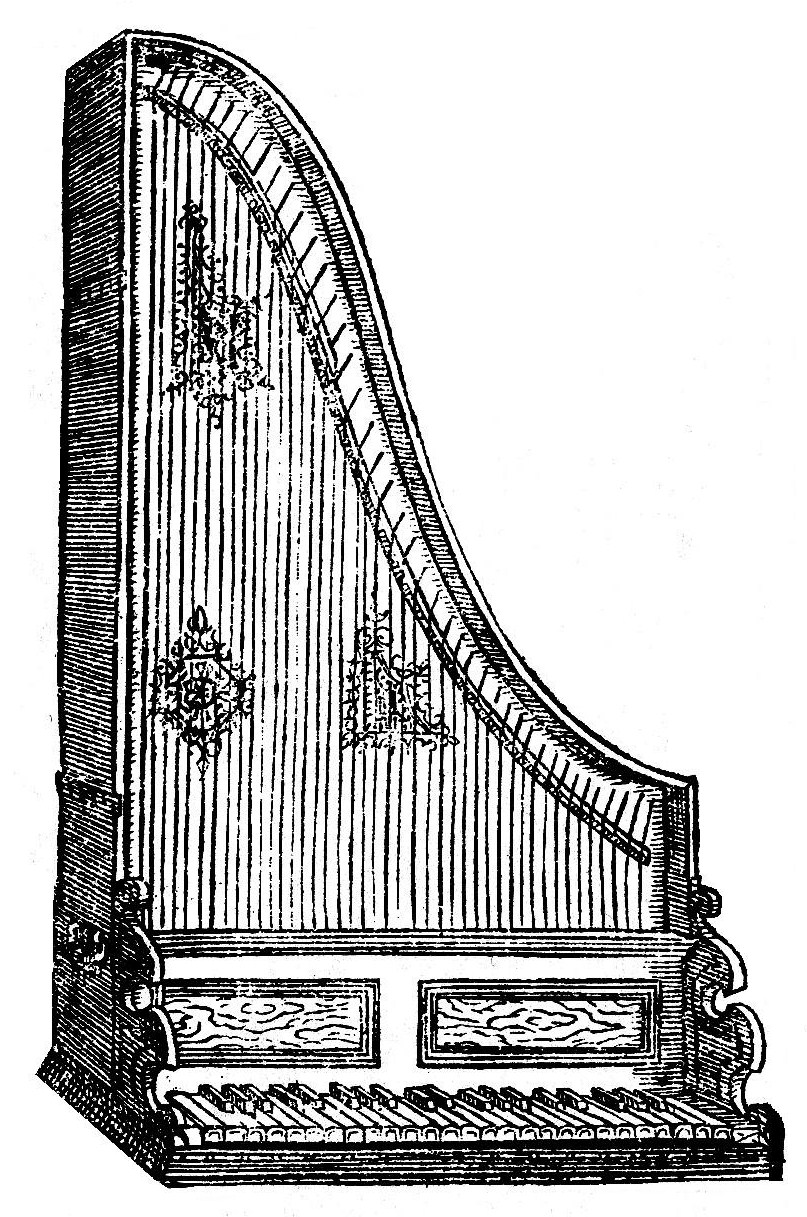|
Epigonion
The epigonion ( el, ἐπιγόνιον) was an ancient stringed instrument, possibly a Greek harp mentioned in Athenaeus (183 AD), probably a psaltery. Description The epigonion was invented, or at least introduced into Greece, by Epigonus of Ambracia, a Greek musician of Ambracia in Epirus, who was admitted to citizenship at Sicyon as a recognition of his great musical ability and of his having been the first to pluck the strings with his fingers, instead of using the plectrum. The instrument, which Epigonus named after himself, had forty strings. It was undoubtedly a kind of harp or psaltery, since in an instrument of so many strings some must have been of different lengths, for tension and thickness only could hardly have produced forty different sounds, or even twenty, supposing that they were arranged in pairs of unisons. Strings of varying lengths require a frame like that of the harp, or of the Egyptian cithara which had one of the arms supporting the cross bar or zugo ... [...More Info...] [...Related Items...] OR: [Wikipedia] [Google] [Baidu] |
Ancient Greek Harps
} The psalterion (Greek ψαλτήριον) is a stringed, plucked instrument, an ancient Greek harp. Psalterion was a general word for harps in the latter part of the 4th century B.C. It meant "plucking instrument." In addition to their most important stringed instrument, the seven-stringed lyre, the Greeks also used multi-stringed, finger-plucked instruments: harps. The general name for these was the psalterion. Ancient vase paintings often depict – almost always in the hands of women – various types of harps. Names found in written sources include pektis, trigonos, magadis, sambuca, epigonion. These names could denote instruments of this type. Unlike the lyres, the harp was rarely used in Greece. It was seen as an "outside instrument" from the Orient. It also touched on Greek social mores, being used mainly by women, both upper-class women as well as hetaerae entertainers. There was a group of women known as ''psaltriai'', female pluckers of the instrument who could be ... [...More Info...] [...Related Items...] OR: [Wikipedia] [Google] [Baidu] |
Psaltery
A psaltery ( el, ψαλτήρι) (or sawtry, an archaic form) is a fretboard-less box zither (a simple chordophone) and is considered the archetype of the zither and dulcimer; the harp, virginal, harpsichord and clavichord were also inspired by it. Its resonance box is usually trapezoidal, rectangular or in the form of a "pig's head" and often richly decorated. Etymology The psaltery of Ancient Greece ('' epigonion'') was a harp-like stringed instrument. The word ''psaltery'' derives from the Ancient Greek ψαλτήριον (''psaltḗrion''), "stringed instrument, psaltery, harp" and that from the verb ψάλλω (''psállō''), "to touch sharply, to pluck, pull, twitch" and in the case of the strings of musical instruments, "to play a stringed instrument with the fingers, and not with the plectrum." The psaltery was originally made from wood, and relied on natural acoustics for sound production. In the King James Bible "psaltery", and its plural, "psalteries", are used t ... [...More Info...] [...Related Items...] OR: [Wikipedia] [Google] [Baidu] |
Epigonus Of Ambracia
Epigonus of Ambracia ( grc-gre, Ἐπίγονος Ἀμβρακιώτης; fl. 6th century BC) was a Greek musician from Ambracia in South Epirus, who was admitted to a citizenship at Sicyon, where he lived, performed and taught. The epigonion (string instrument) was invented, or at least introduced in Greece by Epigonus. He was a contemporary of Lasus of Hermione. References *Athenaeus Athenaeus of Naucratis (; grc, Ἀθήναιος ὁ Nαυκρατίτης or Nαυκράτιος, ''Athēnaios Naukratitēs'' or ''Naukratios''; la, Athenaeus Naucratita) was a Greek rhetorician and grammarian, flourishing about the end of t ... iv.183d and xiv, 637f.1.7.The Science of Harmonics in Classical Greeceby Andrew Barker Ancient Greek musicians Ancient Epirotes 6th-century BC Greek people Ancient Greek inventors Ancient Sicyonians {{AncientGreece-bio-stub ... [...More Info...] [...Related Items...] OR: [Wikipedia] [Google] [Baidu] |
Barbiton
The barbiton, or barbitos ( Gr: βάρβιτον or βάρβιτος; Lat. ''barbitus''), is an ancient stringed instrument related to the lyre known from Greek and Roman classics. The Greek instrument was a bass version of the kithara, and belonged in the zither family, but in medieval times, the same name was used to refer to the '' barbat'' a different instrument that is a variety of lute. Error in the use of names The barbat or ''barbud'', began being translated into Latin as ''barbiton'' sometime during the late Middle Ages, a mistaken practice which has passed into English and other European languages through long misuse. The barbat is an unrelated lute-family instrument developed in Persia, whereas the barbiton (a bass kithara) was developed in Greek-speaking western Anatolia, where it was popular, and spread into the rest of the Aegean. ::Throughout this article ''barbiton'' refers ''only'' to the Anatolian / Aegean instrument, and ''barbat'' is the ''only'' nam ... [...More Info...] [...Related Items...] OR: [Wikipedia] [Google] [Baidu] |
Aulos
An ''aulos'' ( grc, αὐλός, plural , ''auloi'') or ''tibia'' (Latin) was an ancient Greek wind instrument, depicted often in art and also attested by archaeology. Though ''aulos'' is often translated as "flute" or " double flute", it was usually a double-reeded instrument, and its sound—described as "penetrating, insisting and exciting"—was more akin to that of the bagpipes, with a chanter and (modulated) drone. An aulete (, ) was the musician who performed on an ''aulos''. The ancient Roman equivalent was the ''tibicen'' (plural ''tibicines''), from the Latin ''tibia,'' "pipe, ''aulos''." The neologism aulode is sometimes used by analogy with '' rhapsode'' and ''citharode'' (citharede) to refer to an ''aulos'' player, who may also be called an aulist; however, aulode more commonly refers to a singer who sang the accompaniment to a piece played on the aulos. Background There were several kinds of ''aulos'', single or double. The most common variety was a reed inst ... [...More Info...] [...Related Items...] OR: [Wikipedia] [Google] [Baidu] |
Salpinx
A salpinx (; plural salpinges ; Greek σαλπιγξ) was a trumpet-like instrument of the ancient Greeks. Construction The salpinx consisted of a straight, narrow bronze tube with a mouthpiece of bone and a bell (also constructed of bronze) of variable shape and size; extant descriptions describe conical, bulb-like, and spherical structures. Each type of bell may have had a unique effect on the sound made by the instrument. The instrument has been depicted in some classical era vases as employing the use of a phorbeia, similar to those used by aulos players of the era. Though similar to the Roman tuba, the salpinx was shorter than the approximately 1.5 meter long Roman tuba. A rare example of a salpinx, held at the Museum of Fine Arts, Boston, is unique in that it is constructed from thirteen sections of bone connected using tenons and sockets (with bronze ferrules) rather than the long, bronze tube described elsewhere. This salpinx is over 1.57 m long dwarfing the common sa ... [...More Info...] [...Related Items...] OR: [Wikipedia] [Google] [Baidu] |
Mauretania
Mauretania (; ) is the Latin name for a region in the ancient Maghreb. It stretched from central present-day Algeria westwards to the Atlantic, covering northern present-day Morocco, and southward to the Atlas Mountains. Its native inhabitants, seminomadic pastoralists of Berber ancestry, were known to the Romans as the Mauri and the Masaesyli. In 25 BC, the kings of Mauretania became Roman vassals until about 44 AD, when the area was annexed to Rome and divided into two provinces: Mauretania Tingitana and Mauretania Caesariensis. Christianity spread there from the 3rd century onwards. After the Muslim Arabs subdued the region in the 7th century, Islam became the dominant religion. Moorish kingdom Mauretania existed as a tribal kingdom of the Berber Mauri people. In the early 1st century Strabo recorded ''Maûroi'' (Μαῦροι in greek) as the native name of a people opposite the Iberian Peninsula. This appellation was adopted into Latin, whereas the Greek name f ... [...More Info...] [...Related Items...] OR: [Wikipedia] [Google] [Baidu] |
Ancient Greek Musical Instruments
Ancient history is a time period from the beginning of writing and recorded human history to as far as late antiquity. The span of recorded history is roughly 5,000 years, beginning with the Sumerian cuneiform script. Ancient history covers all continents inhabited by humans in the period 3000 BCAD 500. The three-age system periodizes ancient history into the Stone Age, the Bronze Age, and the Iron Age, with recorded history generally considered to begin with the Bronze Age. The start and end of the three ages varies between world regions. In many regions the Bronze Age is generally considered to begin a few centuries prior to 3000 BC, while the end of the Iron Age varies from the early first millennium BC in some regions to the late first millennium AD in others. During the time period of ancient history, the world population was already exponentially increasing due to the Neolithic Revolution, which was in full progress. While in 10,000 BC, the world population stood ... [...More Info...] [...Related Items...] OR: [Wikipedia] [Google] [Baidu] |
Syrinx (instrument)
A pan flute (also known as panpipes or syrinx) is a musical instrument based on the principle of the closed tube, consisting of multiple pipes of gradually increasing length (and occasionally girth). Multiple varieties of pan flutes have been popular as folk instruments. The pipes are typically made from bamboo, giant cane, or local reeds. Other materials include wood, plastic, metal and ivory. Name The pan flute is named after Pan, the Greek god of nature and shepherds often depicted with such an instrument. The pan flute has become widely associated with the character Peter Pan created by Sir James Matthew Barrie, whose name was inspired by the god Pan. In Greek mythology, Syrinx (Σύριγξ) was a forest nymph. In her attempt to escape the affection of god Pan (a creature half goat and half man), she was transformed into a water-reed or calamos (cane-reed). Then, Pan cut several reeds, placed them in parallel one next to the other, and bound them together to make ... [...More Info...] [...Related Items...] OR: [Wikipedia] [Google] [Baidu] |
Physical Modeling Synthesis
Physical may refer to: *Physical examination In a physical examination, medical examination, or clinical examination, a medical practitioner examines a patient for any possible medical signs or symptoms of a medical condition. It generally consists of a series of questions about the patie ..., a regular overall check-up with a doctor * ''Physical'' (Olivia Newton-John album), 1981 ** "Physical" (Olivia Newton-John song) * ''Physical'' (Gabe Gurnsey album) * "Physical" (Alcazar song) (2004) * "Physical" (Enrique Iglesias song) (2014) * "Physical" (Dua Lipa song) (2020) *"Physical (You're So)", a 1980 song by Adam & the Ants, the B side to " Dog Eat Dog" * ''Physical'' (TV series), an American television series See also {{disambiguation ... [...More Info...] [...Related Items...] OR: [Wikipedia] [Google] [Baidu] |
Clavicytherium
A clavicytherium is a harpsichord in which the soundboard and strings are mounted vertically facing the player. The primary purpose of making a harpsichord vertical is the same as in the later upright piano, namely to save floor space. In a clavicytherium, the jacks move horizontally without the assistance of gravity, so that clavicytherium actions are more complex than those of other harpsichords. Design In any harpsichord, the strings are plucked by small plectra, held by jacks, which are thin strips of wood. In a standard harpsichord, the strings are placed horizontally and the jacks are vertical. Thus to make the jack return to position (after it has been lifted by a key to pluck) is a simple matter of gravity; with proper adjustment the jack will simply fall back into its rest position (for details and diagrams see ''harpsichord''). A clavicytherium sacrifices this simplicity and must find some other means to make the jacks return. In some instruments, this is accomplished ... [...More Info...] [...Related Items...] OR: [Wikipedia] [Google] [Baidu] |








